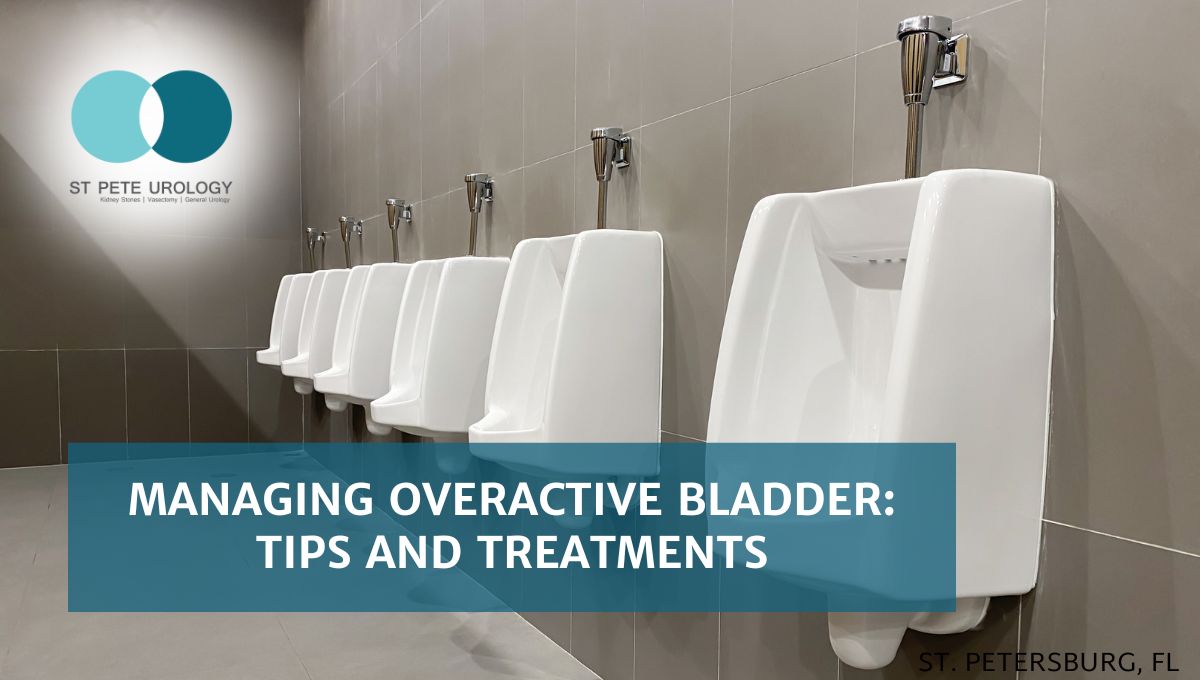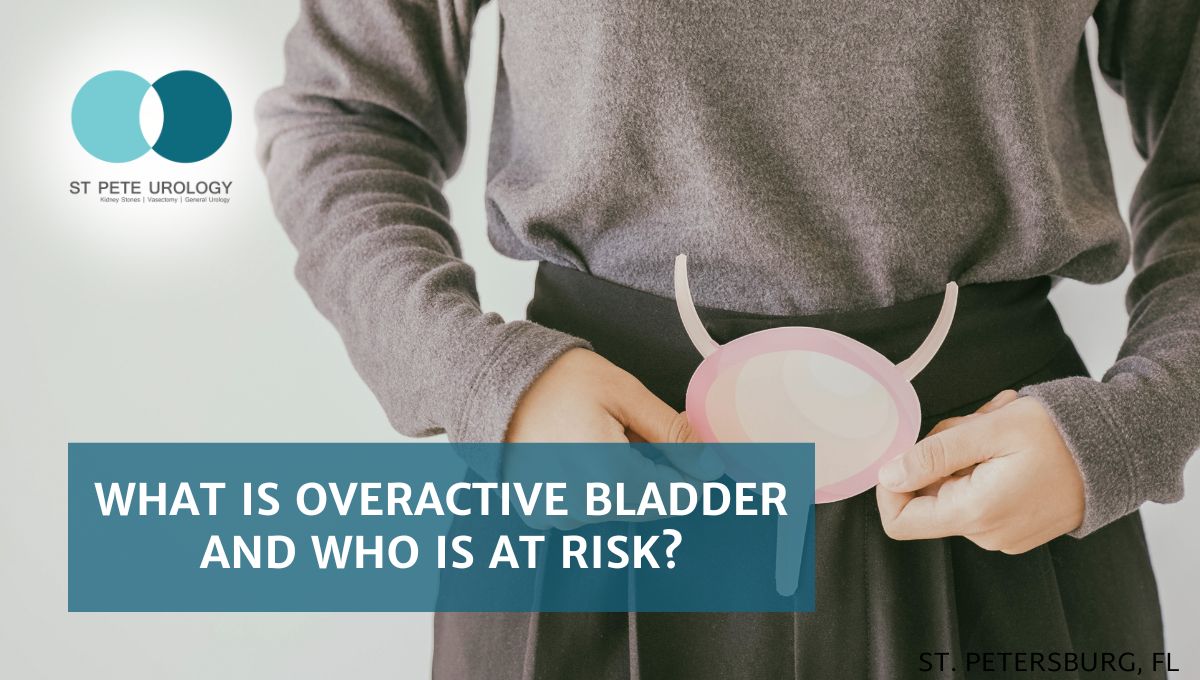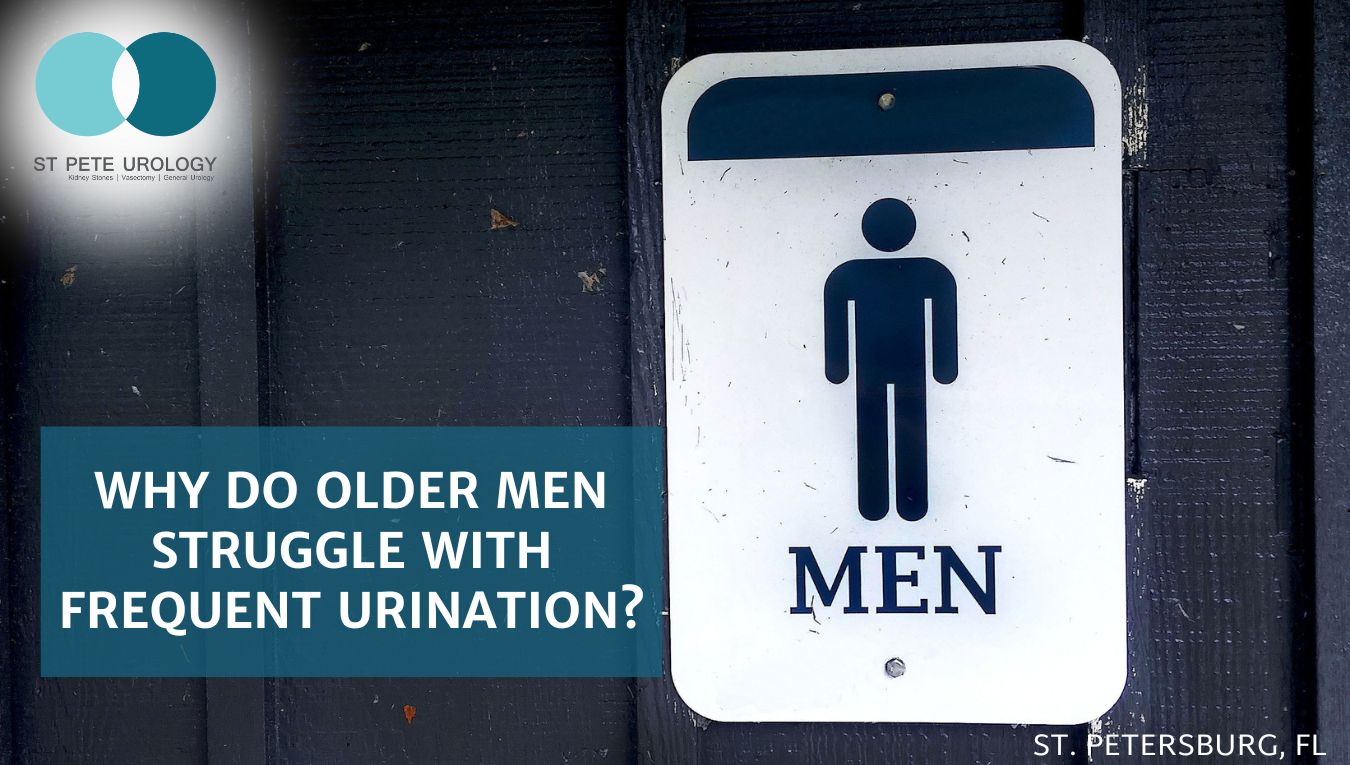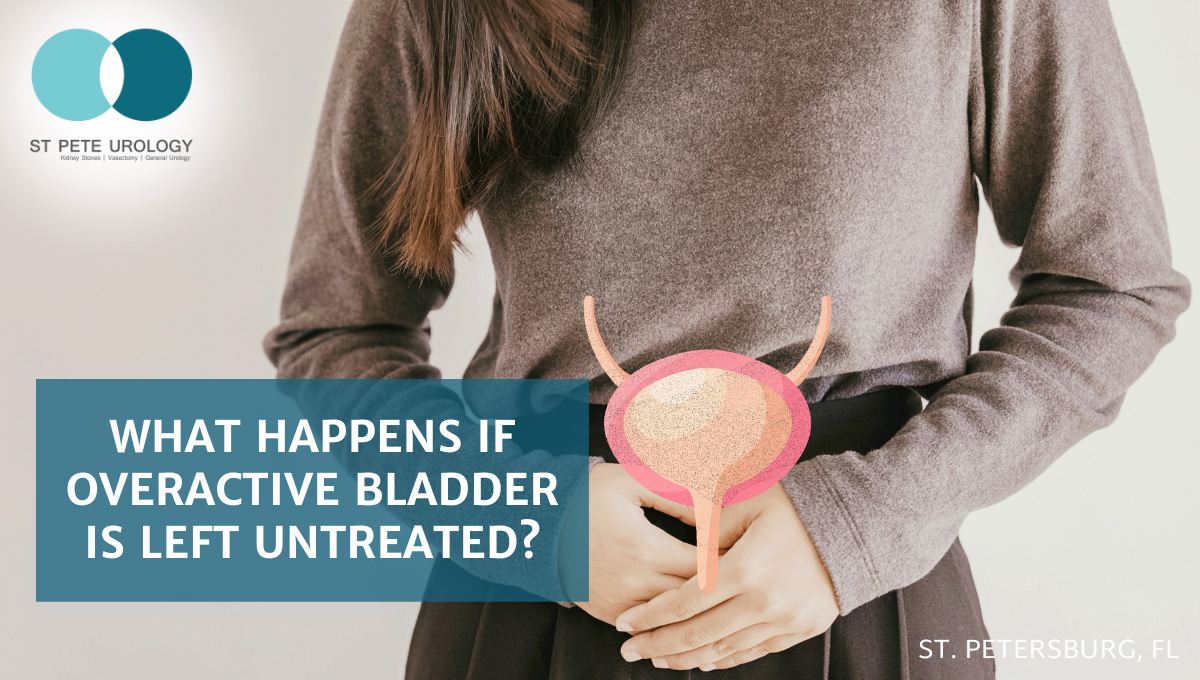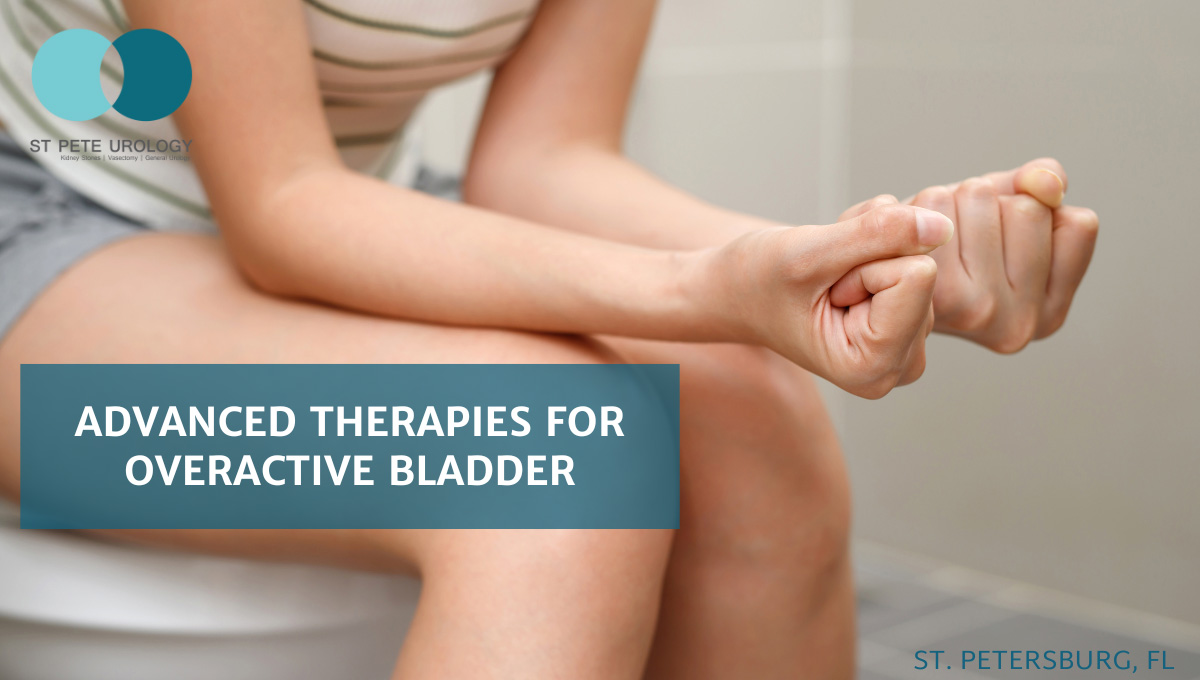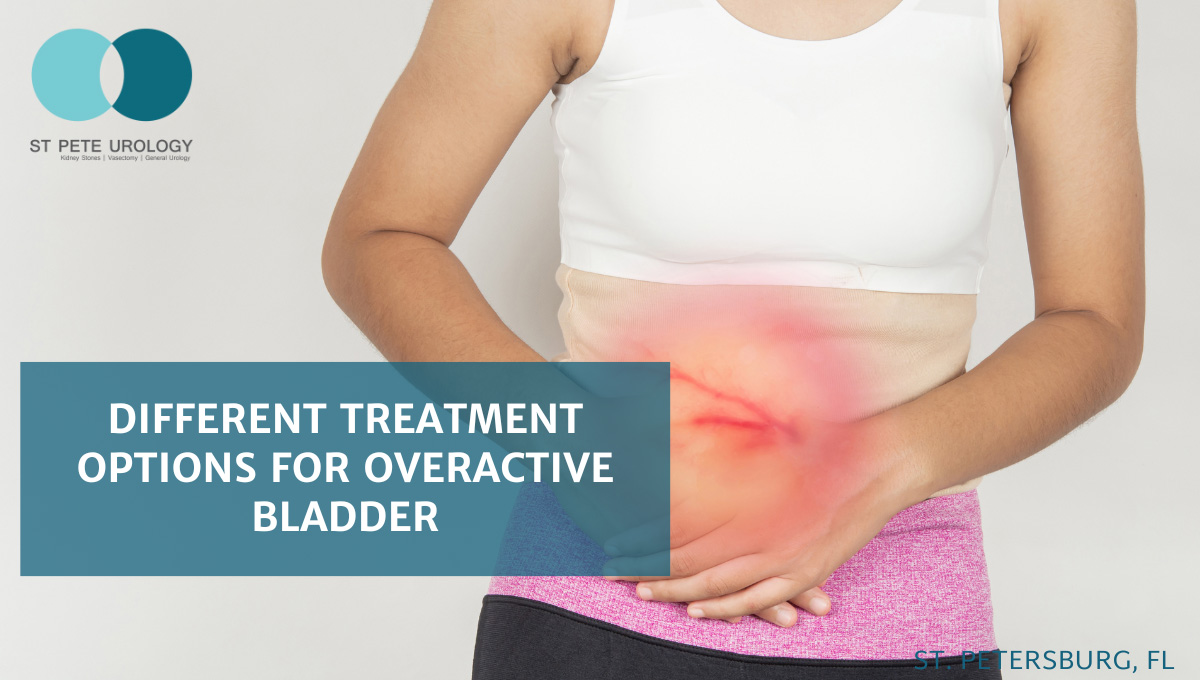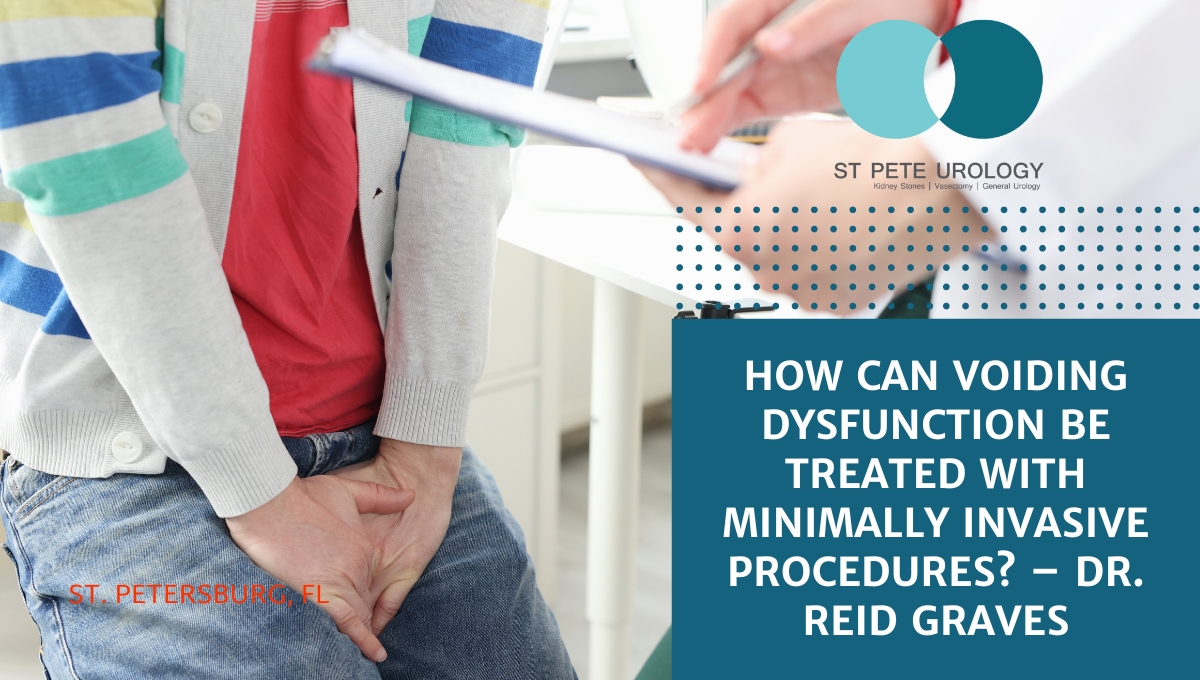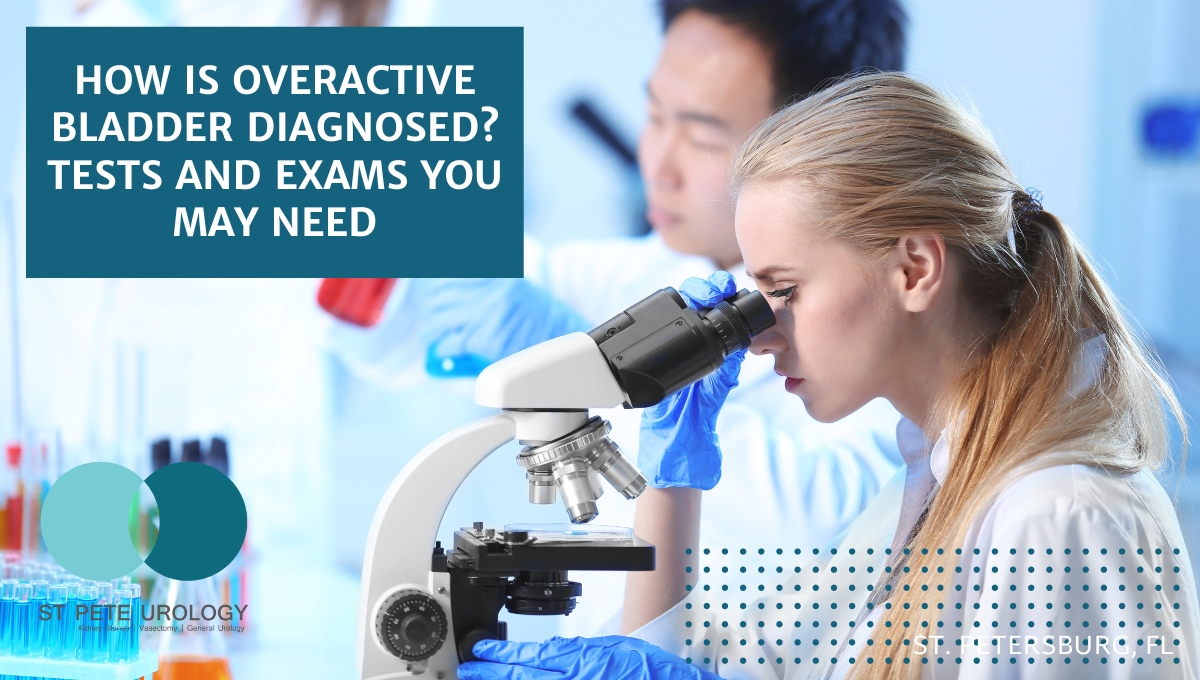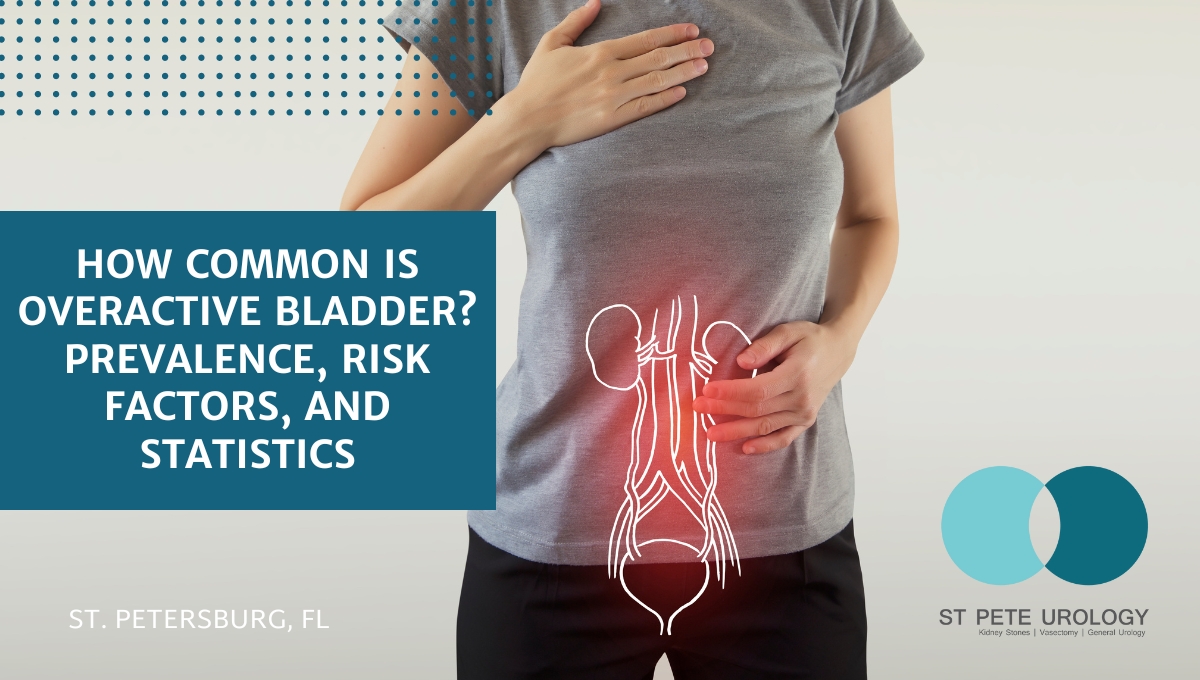Lifestyle changes for overactive bladder include diet modifications, bladder training, and exercise. Learn 7 proven strategies from St. Pete Urology.
Continue readingManaging Overactive Bladder: Tips and Treatments
Discover effective overactive bladder treatment options. Learn practical tips and strategies to manage symptoms and regain control of your daily life.
Continue readingWhat Is Overactive Bladder and Who Is at Risk?
Learn what is overactive bladder, its symptoms, who’s at risk, and when to seek care in St. Petersburg. Regain control—contact our urology experts.
Continue readingWhy Do Older Men Struggle with Frequent Urination?
Discover why frequent urination in older men occurs, its impact on daily life, and effective treatment options to improve quality of life.
Continue readingWhat Happens If Overactive Bladder Is Left Untreated?
Left untreated, overactive bladder can wreak havoc on daily life. Interrupted sleep, stress and anxiety are some of the effects of OAB.
Continue readingAdvanced Therapies for Overactive Bladder
Advanced therapies for overactive bladder include the Medtronic InterStim System, Botox injections and more. Learn more here at St Pete Urology.
Continue readingDifferent Treatment Options for Overactive Bladder
Understanding the different treatment options for overactive bladder will lead to a more accurate and personalized treatment plan.
Continue readingHow Can Voiding Dysfunction Be Treated with Minimally Invasive Procedures? – Dr. Reid Graves
Key Takeaways:
- Voiding dysfunction is a common problem among men which can cause frequent trips to the bathroom, difficulty emptying the bladder, and interrupted sleep.
- Minimally invasive procedures, such as green light laser surgery, can provide relief from voiding dysfunction with less blood loss, recovery time, and hospital stays.
- It is important to seek help from an experienced urologist when considering treatments for voiding dysfunction. St. Pete Urology in St. Petersburg, FL is committed to providing quality care to those struggling with this issue.
Introduction: A Common Problem Faced by Many Men
You’re not alone if you’re struggling with voiding dysfunction. It is one of the most common complaints that men have when they seek the help of a urologist. Dr. Reid Graves, a board-certified urologist, practices at St. Pete Urology in St. Petersburg, FL. He is here to assist individuals grappling with this frustrating issue. Let’s explore how minimally invasive procedures can provide relief and improve your quality of life.
Understanding Voiding Dysfunction
Voiding dysfunction can impact men’s lives in various ways, such as frequent and urgent trips to the bathroom, difficulty emptying the bladder, and interrupted sleep. This condition occurs when there’s a problem with the connection between the bladder and the urethra. It’s often caused by an enlarged prostate. This creates challenges as men attempt to urinate, leading to a range of unpleasant symptoms. Dr. Graves emphasizes the importance of finding an effective treatment, stating, “There are many options for treatment in this often difficult area.”
The Wonders of Minimally Invasive Procedures
In the past, treatment options for voiding dysfunction often involved more invasive surgeries. Now, advanced technology has made minimally invasive procedures a reality. These options significantly reduce blood loss, recovery time, and hospital stays. Dr. Graves mentions one popular minimally invasive treatment, saying, “Some of the things patients might have heard of are minimally invasive laser procedures such as the green light laser surgery of the prostate.” He goes on to explain how this innovative procedure compares to the traditional TURP method. In the traditional approach, the inside part of the prostate is removed. This is to improve the connection between the bladder and the urethra.
Green Light Laser Surgery – A Game Changer
Green light laser surgery has revolutionized the way urologists treat voiding dysfunction. This minimally invasive procedure works by removing the obstructing prostate tissue with a laser, allowing for improved urinary flow. Dr. Graves highlights the benefits of this procedure, saying, “The laser allows less blood loss and less hospital stay, and often patients go home the same day.” The reduced recovery time and minimal discomfort make it a preferred option for many men dealing with voiding dysfunction.
Finding the Right Urologist for You
It’s crucial to choose a urologist who has extensive experience and training in treating voiding dysfunction, especially when considering minimally invasive procedures. Dr. Graves assures that at St. Pete Urology, they have had “extensive comprehensive urologic training and it’s one of the best urology programs in the country.” Trusting your care to a skilled and knowledgeable urologist is the first step toward finding relief from voiding dysfunction.
Don’t Suffer in Silence – Seek Help From St. Pete Urology
Voiding dysfunction doesn’t have to control your life. With the innovative and minimally invasive procedures available at St. Pete Urology in St. Petersburg, FL, you can get back to enjoying your daily activities without constant worry about your urinary health. Don’t hesitate to reach out to the experienced urologists at St. Pete Urology, where they’re committed to helping you find the relief you deserve.
References:
- “Voiding Dysfunction – Urology – UCLA Health.” https://www.uclahealth.org/medical-services/urology/conditions-treated/adult-conditions/voiding-dysfunction.
- “BPH Laser Therapy With Greenlight | Laser for Enlarged Prostate.” https://www.treatmybph.com/bph-patient-us/treatment-options/laser-therapy-with-greenlight.html.
- “Voiding Dysfunction – Treatment Options – New York.” https://my.clevelandclinic.org/health/diseases/16394-non-neurogenic-voiding-dysfunction.
Transcription:
Hi, I’m Dr. Reid Graves and I’m a board certified urologist at St. Pete Urology.
One of the most common presenting complaints of men that present to a urology office is voiding dysfunction and trouble with urination. There are many options for treatment in this often difficult area for men to deal with and some of these are maximally invasive and but many of the options we have are minimally invasive.
Some of the things patients might have heard of are minimally invasive laser procedures such as the green light laser surgery of the prostate which is similar to what often people have heard of which is called a TURP where the inside part of the prostate is removed so that patients can void through their prostate which connects between the bladder and the urethra. The laser allows less blood loss and less hospital stay and often patients go home the same day. We had extensive comprehensive urologic training and it’s one of the best urology programs in the country.
How is Overactive Bladder Diagnosed? Tests and Exams You May Need
Key Takeaways:
1. OAB is a common bladder condition that affects over 200 million people globally, potentially impacting an individual’s quality of life.
2. Accurate diagnosis of OAB can be made through physical examination, bladder tests and imaging tests.
3. Treatment for OAB typically includes lifestyle changes, medications, and behavioral therapy. St Pete Urology is an excellent provider for diagnosis and treatment in the St. Petersburg area.
 Having a condition like an overactive bladder (OAB) can be a source of embarrassment and discomfort for an individual. Furthermore, this condition ranks among the most common bladder issues. Overactive Bladder (OAB) is characterized by a sudden and intense urge to urinate, often occurring more than 8 times a day and/or causing frequent awakenings during the night for urination (2 or more times per night). Globally, it impacts over 200 million people and can significantly disrupt one’s quality of life. In this article, we will elucidate the process of diagnosing OAB, outlining the necessary tests and examinations, available treatments, and emphasizing the importance of early diagnosis and intervention.
Having a condition like an overactive bladder (OAB) can be a source of embarrassment and discomfort for an individual. Furthermore, this condition ranks among the most common bladder issues. Overactive Bladder (OAB) is characterized by a sudden and intense urge to urinate, often occurring more than 8 times a day and/or causing frequent awakenings during the night for urination (2 or more times per night). Globally, it impacts over 200 million people and can significantly disrupt one’s quality of life. In this article, we will elucidate the process of diagnosing OAB, outlining the necessary tests and examinations, available treatments, and emphasizing the importance of early diagnosis and intervention.
Diagnosis of Overactive Bladder
The first step towards an accurate diagnosis of OAB is to make a thorough patient medical history to review prior medical history and possible underlying medical conditions that could be contributing to OAB. After an initial review, a physical examination is the next necessary step. The physical examination can provide important clues as to the possible causes of the OAB symptoms. After physical examination, bladder tests and imaging tests are the most common tests used to diagnose OAB with accurate precision.
Bladder Function Tests:
To better understand the individual’s bladder functionality, bladder function tests can be carried out. This includes urine flow tests and post-void residual (PVR) tests. Urine flow tests measure the flow rate of urine and the PVR tests measure how much urine is left in the bladder after urination. These tests give important information on the type of OAB and how it is being managed.
Imaging Tests:
Additionally, if other tests yield inconclusive results, healthcare providers may employ imaging tests to diagnose OAB. These tests have the capability to display images of the bladder and urinary tract, aiding in the identification of any underlying issues. These issues may include a blocked or narrowed urethra and abnormalities in bladder muscles or valves. Also, the presence of other underlying conditions like bladder stones or tumors.
Treatment of Overactive Bladder
Once an individual has been diagnosed with OAB, treatments to manage it can be initiated. These treatments are broken down into lifestyle changes, medications, and behavioral therapy.
Lifestyle Changes:
Making lifestyle changes is always the first step to managing OAB. Lifestyle includes reducing substance use, i.e. caffeine, alcohol or other stimulants, that can irritate the bladder. Limiting intake of fluids before bed, potential allergies to certain foods, managing stress, and increasing physical activity levels can also help to reduce pain and symptoms of OAB.
Medication:
If lifestyle changes don’t provide enough relief, medications are typically the second step in the treatment plan. Although these medications can help to reduce OAB symptoms, they can also produce unwanted side effects. Therefore, it is important to review all potential risks and side effects with your doctor before taking any medication.
Behavioral Therapy:
Behavioral therapy is another treatment type for OAB. This type of therapy is designed to help individuals gain better control of their bladders. The therapy helps to build awareness of the body’s signals when the bladders have reached a certain capacity and teaches individuals to delay or prevent urge responses.
Conclusion
Overactive bladder is a condition that affects many people and can cause significant discomfort and disruption to an individual’s daily activities. Accurate diagnosis of OAB can be made through physical examination, bladder tests and imaging tests. Once diagnosis is complete, treatment can begin. Treatments for OAB typically include lifestyle changes, medications, and behavioral therapy. Early diagnosis and treatment of OAB can help to reduce symptoms and improve quality of life.
St Pete Urology is a premier urology practice and leader in diagnosing and treating OAB in the St. Petersburg, Florida area. St Pete Urology’s dedicated team of highly experienced specialists and professional staff members work together to provide you with the best possible treatment so you can get back to living a life free from OAB symptoms and discomfort.
References:
- “Urodynamic Testing: What Is It, Procedure & What To Expect.” 17 Aug. 2020, https://my.clevelandclinic.org/health/diagnostics/15684-urodynamic-testing.
- “Overactive bladder (OAB) and lifestyle modification – Female Urology.” https://www.urineincontinence.com.au/overactive-bladder/overactive-bladder-oab-and-lifestyle-modification.
- “Diagnosing Overactive Bladder – WebMD.” 7 Jun. 2022, https://www.webmd.com/urinary-incontinence-oab/overactive-bladder-making-diagnosis.
How Common is Overactive Bladder? Prevalence, Risk Factors, and Statistics
3 Key Takeaways:
1. Overactive bladder (OAB) is a common urological condition characterized by frequent, urgent urination and disruption of day-to-day life.
2. Risk factors for developing OAB include age, gender, obesity and certain medications.
3. Early diagnosis and treatment for OAB can mitigate symptoms and improve quality of life, and St. Pete Urology can provide high-quality, individualized care for those suffering from OAB.
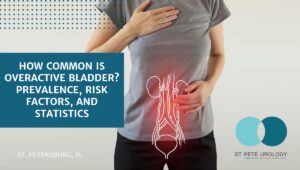 Overactive bladder (OAB) is a urological condition characterized by a sudden, uncontrollable, and frequent urge to urinate. People with OAB may find themselves unable to control their urge to urinate. This can cause issues with daily routines, social activities, emotional wellbeing, and ultimately lead to a decreased quality of life. This article will explore the prevalence, risk factors, and statistics associated with OAB.
Overactive bladder (OAB) is a urological condition characterized by a sudden, uncontrollable, and frequent urge to urinate. People with OAB may find themselves unable to control their urge to urinate. This can cause issues with daily routines, social activities, emotional wellbeing, and ultimately lead to a decreased quality of life. This article will explore the prevalence, risk factors, and statistics associated with OAB.
Prevalence of OAB
According to Statistic Brain, an estimated 183 million people suffer from OAB globally. Regionally, the prevalence of OAB is highest in North America, with an estimated 66.6 million people in the U.S. are currently experiencing OAB symptoms. The global and regional prevalence of OAB is largely influenced by a range of environmental and demographic factors. These factors include the aging population, rising global health awareness, sedentary lifestyle choices, and shifts in healthcare policies.
Risk Factors for OAB
There are a number of risk factors that may increase the likelihood of developing OAB. These include age, gender, obesity, urinary tract infections, strokes and other neurological diseases, diabetes, and certain medications. Studies have shown that women are more likely to experience OAB than men, with the risk increasing with age for both genders. Additionally, there is a strong correlation between obesity and OAB, with obese individuals having a higher risk of developing OAB.
Symptoms and Impact of OAB
The primary symptoms of OAB include frequent urge to urinate, urgent urination, frequent urination, and nocturia (nighttime urination). These symptoms can cause disruption in daily life, leading to difficulties with social activities, work, and maintaining relationships. Additionally, OAB can cause emotional and mental distress, leading to anxiety, embarrassment, and depression.
Diagnosis of OAB
OAB can be effectively diagnosed with a variety of tests and procedures, including physical examinations, urine tests, urine flow tests, and bladder scans. It is important to seek early diagnosis and treatment for OAB, as this can help minimize the disruption caused by the condition.
Treatment and Management of OAB
The treatment and management of OAB will depend on the individual patient, with a range of options available, including lifestyle changes, medications, bladder training, and physical therapy. It is important to discuss treatment options with a healthcare professional, as some medications may not be suitable for all patients. Additionally, lifestyle changes and self-management strategies can help to mitigate the symptoms of OAB and improve the quality of life.
Conclusion
Overactive bladder is a common urological condition characterized by frequent, urgent urination and disruption of day-to-day life. It is important to be aware of the prevalence, risk factors, and statistics associated with OAB. Key risk factors for developing OAB include age, gender, obesity, and certain medications. It is important to seek early diagnosis and treatment for OAB, as this can help to reduce the symptoms and improve the overall quality of life.
At St. Pete Urology, we strive to provide high-quality, individualized care for those suffering from common urological conditions such as overactive bladder. With our comprehensive and comprehensive approach, you can trust us to provide you with the most effective solutions for your OAB symptoms. Contact us today to schedule an appointment and get on the path to feeling your best!
References:
- “Incontinence Types & Risk Factors – Brigham and Women’s Hospital.” https://www.brighamandwomens.org/obgyn/urogynecology/types-of-incontinence-and-risk-factors.
- “Overactive bladder – Diagnosis and treatment – Mayo Clinic.” 3 May. 2022, https://www.mayoclinic.org/diseases-conditions/overactive-bladder/diagnosis-treatment/drc-20355721.
- “Urinary Incontinence risk factors – Hospital Clínic Barcelona.” 20 Feb. 2018, https://www.clinicbarcelona.org/en/assistance/diseases/urinary-incontinence/risk-factors.


